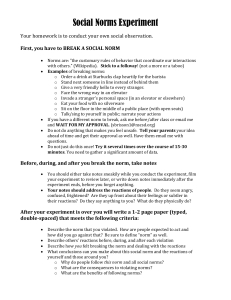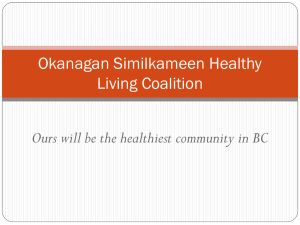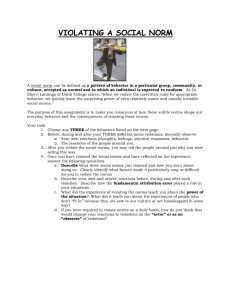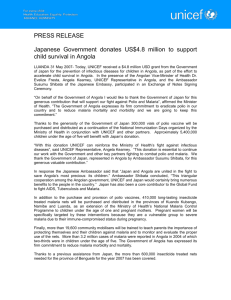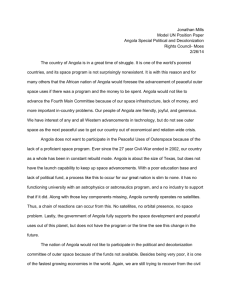Introducing a social norms perspective to programming on the right
advertisement
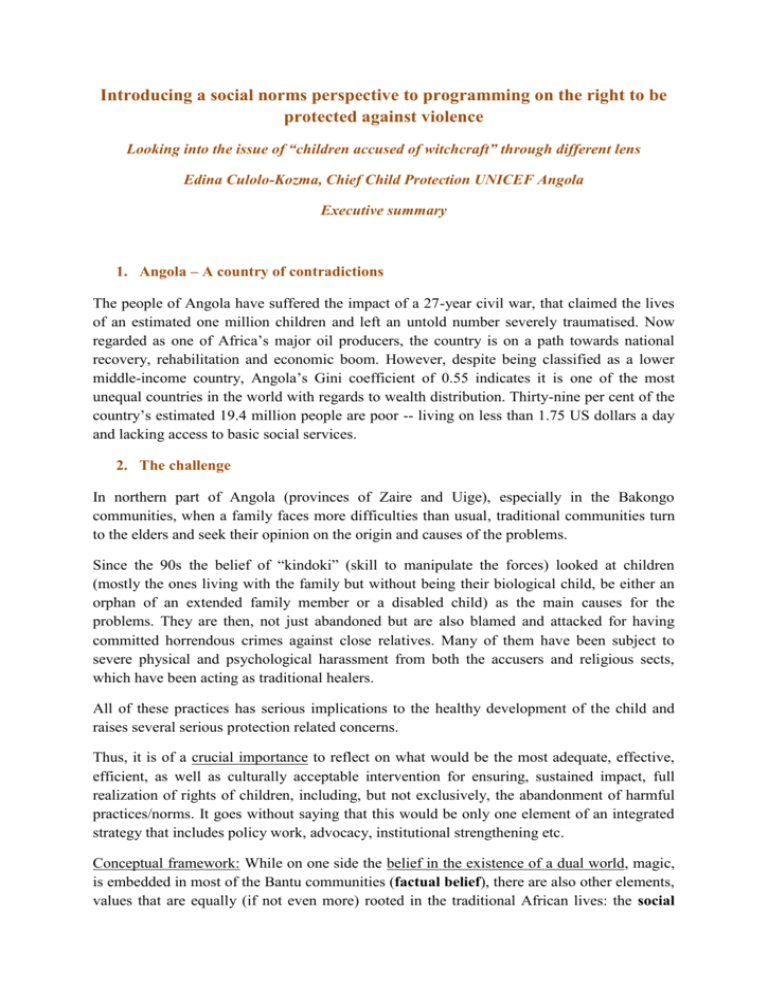
Introducing a social norms perspective to programming on the right to be protected against violence Looking into the issue of “children accused of witchcraft” through different lens Edina Culolo-Kozma, Chief Child Protection UNICEF Angola Executive summary 1. Angola – A country of contradictions The people of Angola have suffered the impact of a 27-year civil war, that claimed the lives of an estimated one million children and left an untold number severely traumatised. Now regarded as one of Africa’s major oil producers, the country is on a path towards national recovery, rehabilitation and economic boom. However, despite being classified as a lower middle-income country, Angola’s Gini coefficient of 0.55 indicates it is one of the most unequal countries in the world with regards to wealth distribution. Thirty-nine per cent of the country’s estimated 19.4 million people are poor -- living on less than 1.75 US dollars a day and lacking access to basic social services. 2. The challenge In northern part of Angola (provinces of Zaire and Uige), especially in the Bakongo communities, when a family faces more difficulties than usual, traditional communities turn to the elders and seek their opinion on the origin and causes of the problems. Since the 90s the belief of “kindoki” (skill to manipulate the forces) looked at children (mostly the ones living with the family but without being their biological child, be either an orphan of an extended family member or a disabled child) as the main causes for the problems. They are then, not just abandoned but are also blamed and attacked for having committed horrendous crimes against close relatives. Many of them have been subject to severe physical and psychological harassment from both the accusers and religious sects, which have been acting as traditional healers. All of these practices has serious implications to the healthy development of the child and raises several serious protection related concerns. Thus, it is of a crucial importance to reflect on what would be the most adequate, effective, efficient, as well as culturally acceptable intervention for ensuring, sustained impact, full realization of rights of children, including, but not exclusively, the abandonment of harmful practices/norms. It goes without saying that this would be only one element of an integrated strategy that includes policy work, advocacy, institutional strengthening etc. Conceptual framework: While on one side the belief in the existence of a dual world, magic, is embedded in most of the Bantu communities (factual belief), there are also other elements, values that are equally (if not even more) rooted in the traditional African lives: the social script of kinship care. However, as a consequence of poverty (influencing factor) families are less and less capable of taking care of these children, the child may be conceived as a burden, out of control, an element of disturbance - and parents and other members of the older generation may respond by turning away, by abandoning the child or by aggression. Recently, the accusation of witchcraft became a “culturally valid justification“ for abandoning an orphan child decreasing this way the economic burden of the family. Expressive values (legal norms) are emerging through the strengthening of the rights framework, as well as high level political commitments in terms of promotion of child rights and the abandonment of harmful traditional practices. Formal legal system and norms are non-operational and non-valid at rural level (legal norms are far from social and moral norms) and enforcement and access to formal justice remains a challenge. In addition to this, the high level of corruption and bribes could contribute to a potential social norm of disobedience which should also be analysis of further studies whenever a law making process is happening. As a result of lack of alternatives (or knowledge of or limited access to alternatives) families either abandon those children that are being accused as cause and origin of the problem, expulse them from home or take them to traditional healers to take away the bad spirit through different processes that put the child’s physical integrity in danger (empirical expectations) Families in these communities think that both their extended families as well as the local community think they should follow this process, identify who is the responsible for the difficulties and take these children to the traditional healer (normative expectations). In the current context, most of the Angolans avoid making confirmations nor admit that their actions and behaviors are influenced by their belief (or not) in witchcraft, the fact that in certain communities questioning the existence of dual world would be unprecedented, unacceptable and would seriously question the position and legitimacy of that person (family) in a certain community has a serious (determinant) impact on the preferences and behaviors of the members of the community. As one of the conclusions of the analysis of the conceptual framework, the contradiction between the social, moral and legal norms is clear. While Angolans (including Bakongos) has a strong belief in witchcraft, their obligation to raise an orphan child of a family member is also embedded in their moral values, together with the emerging expressive value of the legal norms that prohibits violence against children and promote the best interest of the child at all levels. 3. Critical Evaluation of the Work So Far and Proposed Changes in Practice UNICEF Angola together with the National Institute for Children addressed the phenomenon of children accused of witchcraft in early 2000 through two researches one from a human rights and the other from an anthropological perspective with detailed analysis of the problem from an institutional (macro) point of view, elaborated in detail on the rights framework and obligations of the State, the availability of services as well as the root structural causes of the accusations (poverty). Programmatic interventions were focusing on identification and training of community child protection networks, relevant groups, and advocacy for criminalization and stronger sanctions for violence against children, establishment of strategic plans of response. While some additional actions could be implemented based on existing analysis, the following NEW analysis and consequent actions are required: 1. Additional Research from social norm perspective: a) the reasons and motivations why people engage in these activities b) Identify the entire reference network and implement a network analysis 2. Engage in a Community led dynamic process for changing empirical expectations and ensure coordinated and sustained abandonment 3. Design a communication strategy – social marketing 4. Introduce regional, multi-country perspective 4. Additional preliminary thoughts on social norm perspective to Child Protection programing The social norm perspective enriches our programming and daily work in a multiple way. It does not only pushes for more sustained results and impacts for the overarching goal, the realization of child rights, but also add in crucial elements to both human rights based and result oriented programming. With one foot on the ground and one foot in the Minister’s office, UNICEF’s reach and sphere of influence is unique. We work upstream with the Government including on advocacy and policy leveraging. At the same time our so-called midstream work focuses on creating and strengthening systems, building capacity and introducing technological advances. And with presence in five provinces, UNICEF is well-positioned ‘downstream’ in the areas of social mobilization, modeling projects on the ground and networking amongst partners and actors from the commune level, to the Governor’s front office. The social norm perspective contributes to, strengthen UNICEF comparative advantage in all of these different areas.

